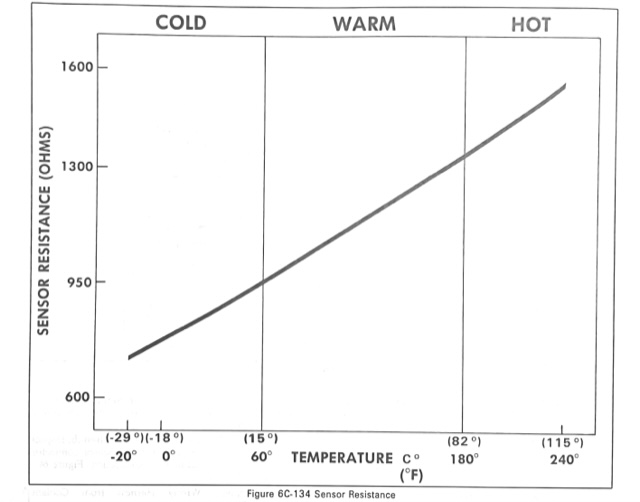OLDS 350 ANALOG EFI SYSTEM 1975-1980
Was it a bad system? Not necessarily. But it is misunderstood, and poorly-informed auto journalists are no exception. In fact, it was what made the 1st Gen Seville unique, and was even offered on the 500 and later the 425 in the full-size cars. Yes, you can install a carb and intake and ditch the setup if you want, and a lot of shade tree mechanics that couldn't be bothered to follow a fault-tree did just that. But compared to modern systems, it's downright archaic (that's a good thing), which means it's also easy to troubleshoot. Can you still get parts? The short answer is a resounding: Mostly.
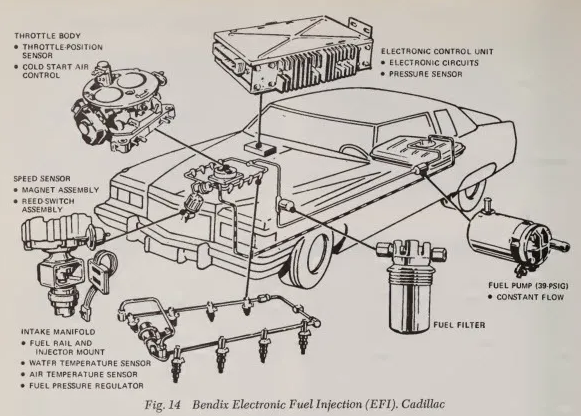 |
If you own one of these cars, or are thinking about buying, pick up the GM EFI manuals. There are 3 different publications, a brown covered EFI Diagnosis Guide, a brown covered “1975 EFI Supplement” (31 pages) and a blue/white guide titled “1976-1978 Electronic Fuel Injection Diagnosis” that runs 79 pages. All three turn up frequently on ebay. The 79 page guide can even be Downloaded HERE.
Some folks claim this is a Bosch system, and a ripoff of VW and Mercedes. That's actually not true. In '57, Chrysler and American Motors offered the first, true, electronic EFI system known as Electrojector. But the components weren't ready for prime time and almost all were converted to carbs (consider resistor drift and wax caps in that environment). Bendix then licensed their patents to Bosch, who eventually released their Jetronic system 10 years later. Ironically, it was US California Emissions requirements which spurred VW to implement this system to get their air-cooled engines to pass.
Now, Jetronic ended up being offered in various flavors over the years, including a mechanical CIS system, a MAF system, a closed-loop sensor system, etc. If you really want to go down a rabbit hole, this is the guy: https://jetronic.org/en/
Anyhow, US cars soldiered on with carbs until the Seville debuted. This was a smart move, as the American public would not have put up with a lot of the Jetronic peculiarities. What the Bendix system did was copy the speed-density design of the D-Jetronic (did it copy if Bendix originated?), but eliminated or improved upon the maintenance intensive parts, like using non-contacting reed switches in the distributor body instead of physical contacts and dispensing with a cold-start injector, for example. The ECU also capitalized on 'state of the art' tech at the time of development. It's actually a rather elegant design compared to Bosch; laser-trimmed resistors on ceramic substrate have remained quite stable as well compared to binned resistors. I believe the only component they share is the TPS.
How It Works:
This is a speed-density, batch-fire system utilizing 8 “peak and hold” injectors on a common fuel rail. An in-tank fuel pump provides 'lift' to a high pressure, frame mounted electric pump that pressurizes the fuel rail up at the engine. A vacuum controlled regulator on the fuel rail adjusts pressure, while a return line feeds excess fuel back to the tank. The rail feeds eight fuel injectors that are wired in two groups, each group fired by a pair of magnetic switches in the body of the distributor. So for each rotation, both banks fire once. (2 revs of the crank for 1 of the dist)
The exact amount of fuel delivered is calculated by an electronic analog computer. People joke about the DEFI badge on early 80's Cads, unaware that analog EFI computers were a thing and that Cadillac, as far as I can tell, was the first with a digital system in '80. When you think about it, this is the perfect application for analog electronics. In this case, the ECU looks at coolant temp, air intake temp, throttle position (sort of) and manifold pressure. It's a true calculation and not just a programmed lookup. When you step on the accelerator, each bank is fired in succession by alternating switch contacts in the TPS, very much an electronic implementation of a carb's accelerator pump.
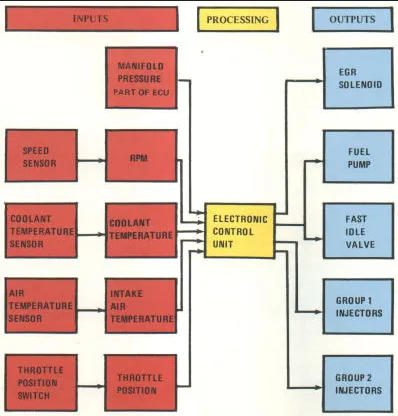 |
If you want to really get into the nitty-gritty, pick up the service pubs linked above and dive-in. I have this setup on my '76 Eldo but also modified it to allow use of a Megasquirt digital ECU (but can fall back on the analog system with a jumper harness). On my previous 85 Eldo 403 conversion, I added this analog system using a 350 intake, and modified ECU for the increase in cubes. Ran like a top with zero complaints.
Tips and Tricks:
+These sensors were unavailable for many years, but are now available thanks to an enterprising individual and CLC member. You can find his replacements on ebay or through various message boards. Replaces GM 1609968 / AC Delco 213-188 / EL31 Hewitt Industries PN 021-104.
A discussion regarding its development can be found HERE.
|
 |
+The Fast Idle Valve is a spring-loaded affair that allows extra air to bypass the closed throttle valves when first started for a higher RPM. Typically they can be shimmed a little to perform the way you want, but if outright bad, the same individual producing new sensors has also released repops of these. They replace: GM 1606776, GM 1617956, GM 1628898 and Bendix 1181290, 1181835. When operating correctly, the valve should fully close in roughly 90 seconds at 70F air temp.
+ECUs can be had from junk cars or ebay, but don't waste your time; have yours repaired. Google Bruce Roe, a true guru on these systems and well known for ECU repair and refurb. More info on his Reverse Engineering Here.
| +The injectors are designed for a 'peak-and-hold' circuit unlike most later systems. A large inrush current opens the injector, whereafter it's reduced to the minimum required to keep it open. When you're firing 4 injectors at a time, this can result in faster opening time and reduced power consumption compared to conventional systems. Replacements for these are available, but I'd recommend sending out your originals for a professional cleaning before throwing in aftermarkets. |  |
|
+The injectors are color-coded: Blue for 500 (Bendix 1181247, GM 1606771), Green for 1977, early '78 & all 1979 425 use green. 1978 Fed Emissions after VIN 223335 use blue |
 |
+Starting in 1978, a closed-loop version of this system was developed using an oxygen sensor, an 8048 microprocessor and a '3-phase' catalytic converter. This was delivered on CA-spec cars, including the 79 and 80 CA Eldorado. The O2 sensor required servicing every 15,000 miles and a mechanical 'Emissions' flag would pop up over the odometer as a reminder. See the Speedometer History section for a pic. A 49-state ECU can be swapped in if desired; the original closed-loop ECU can also be modified to work like a 49-state.
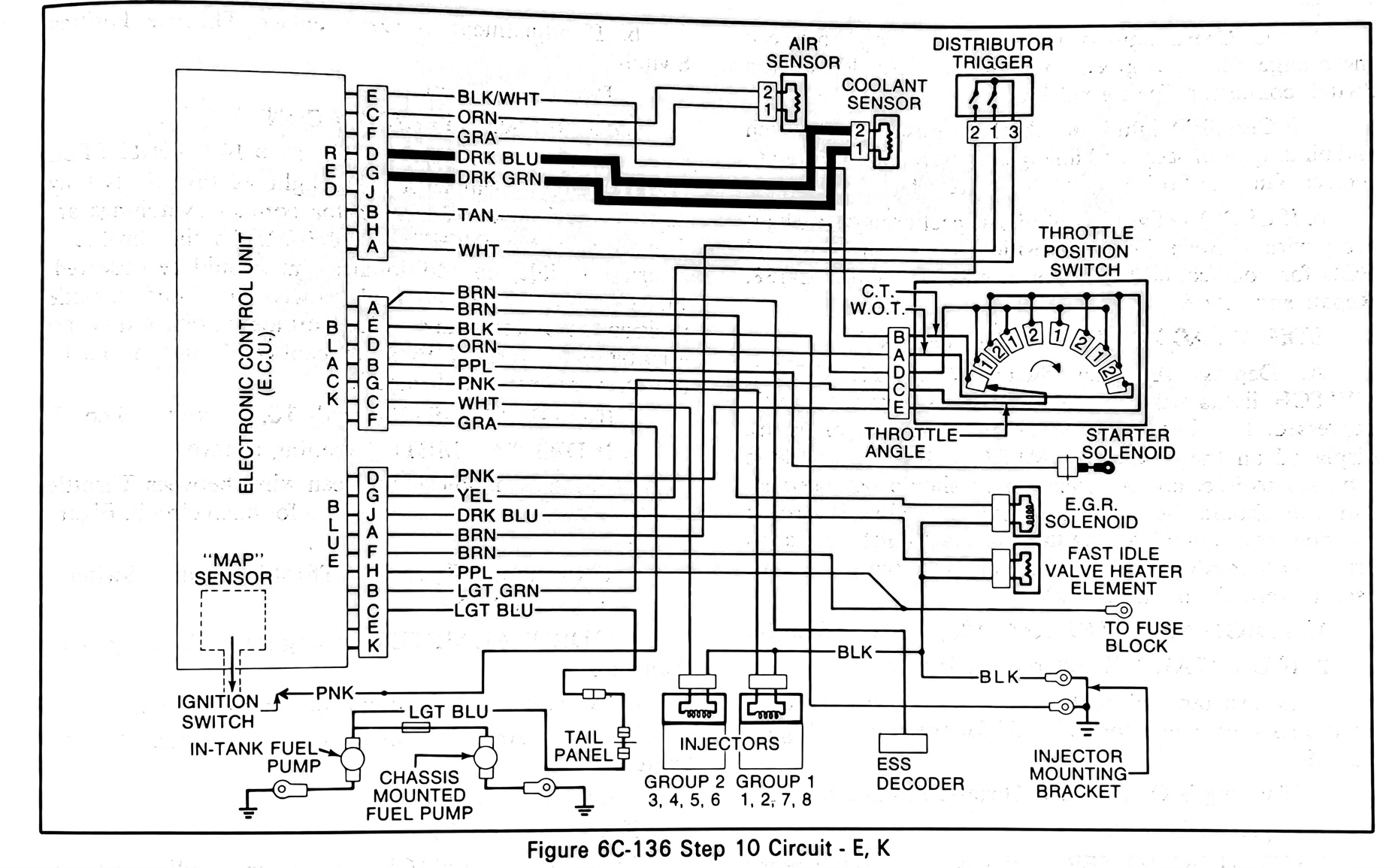 1980 CA-Spec 350 Schematic |
+Injector o-rings, including the rubber bushings for the rail, are readily available for a couple bucks for a complete set. If yours have a few years on them, replace them. See Standard Motor Products SK59, for example, which also includes the copper crush washers used on the fuel rail connections. Available at Napa, Rockauto, etc.
+You can always dispense with the analog ECU and run something digital and tunable, like Megasquirt. They make a 'peak-and-hold' injector driver, and common GM sensors can be used to drive the hardware. I did this on my 76 Eldo with good success. Google will turn up lots of happy customers using the Bendix setup.
+78/79 EFI-equipped cars (as well as CA-spec '80 350 and carb'd 368) have a black box mounted to the firewall, which is an electronic spark system designed to ease cranking and retard timing to reduce exhaust emissions depending on engine temp and load. It's a potted module and non-repairable, and can cause drivability (or no-start) issues if bad. This ESS unit works in conjunction with the HEI's 5-pin module. If you're keeping the EFI, a 76/77 EFI distributor will drop right in. If running a carb, any Olds 350 HEI distributor works. Of course, you can also bypass the ESC. For more about how timing retard works with the 5-pin module, do a little googling. It's a popular modification for guys running turbos, nitrous, or lots of initial timing.
Reliability Issues
These cars predate the widespread adoption of environmental connectors in automobiles; in fact it was EFI that really advanced the harness/connector discipline into what it is today. Because of this, the biggest cause for poor drivability on the early cars are due to dirty connectors. GM changed connector designs within the 1st year to help combat this (moved from flat to barrel connectors on sensors, for example), and even a change on the injectors. The best thing you can do if you're having problems is to inspect, clean and tighten all of your connections. Keeping a spare harness around 'for parts' is a good move, too.
For safety's sake, change any rubber lines (using modern high pressure EFI-rated hose) between the tank and engine. The high pressure is typically a steel line running along the frame, with a short rubber hose to the fuel filter, and another steel line that runs up to the regulator. Early cars had rubber up to the reg and were recalled due to engine fires. While you're at it, see “o-rings” above.
| Relay Upgrade: The fuel pump circuit is powered by a relay which is contained within the ECU. While fused, a genuine risk exists of blowing the PCB trace for the relay first, should a pump short or wiring graze the frame. A simple solution is an external relay. Bruce Roe (mentioned above) has come up with an inexpensive plug-and-play solution which is good insurance for your ECU. He generally has these available at Olds and Cad events, or reach out to him directly. More info here. | 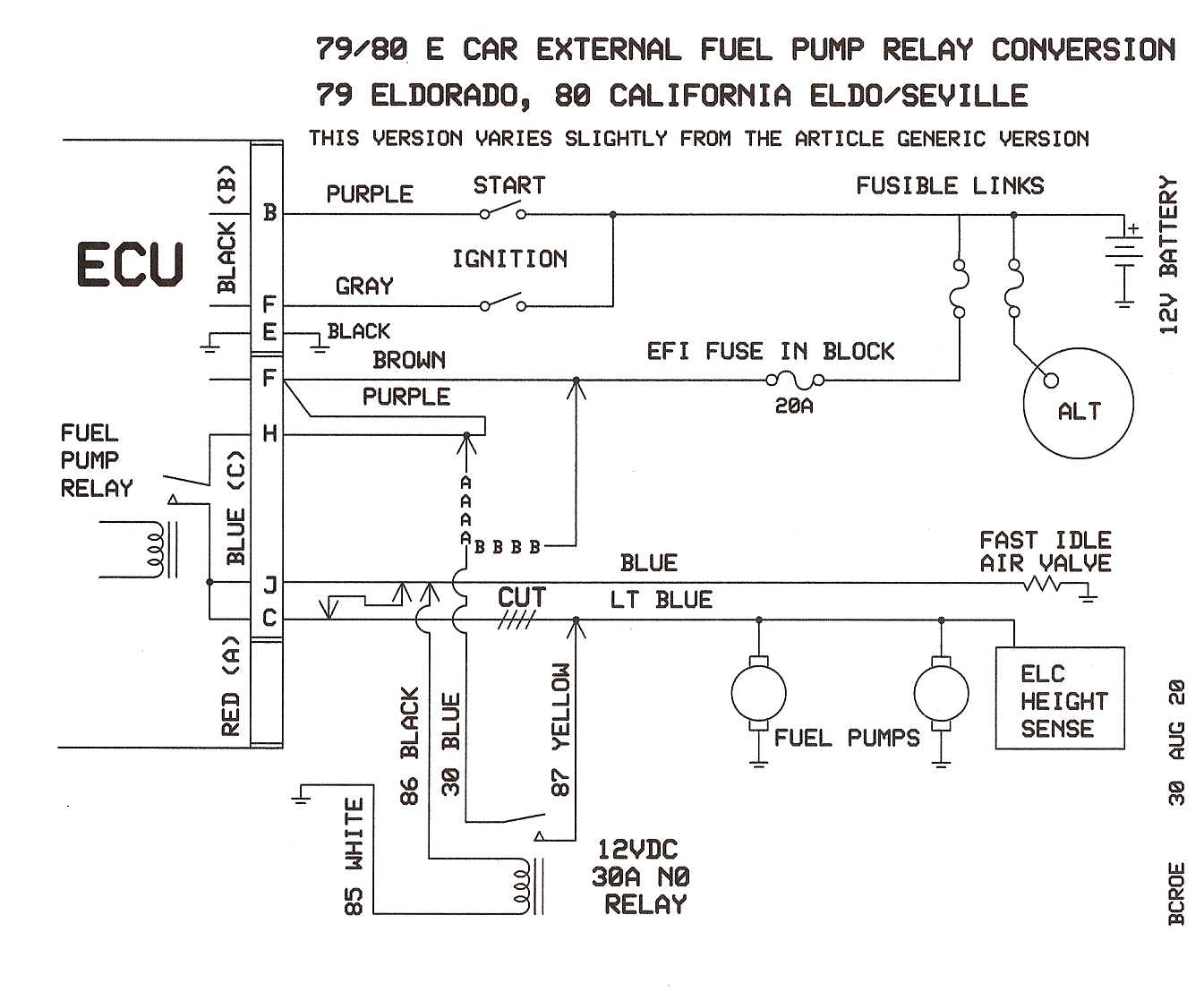 |
| Return to Main Page | Corrections? Additions? Contact Webmaster | Cory Heisterkamp 2022 |

